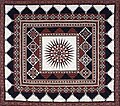Gallery
- Seminole patchwork fringed dance shawl, ca. 1980s, by Susie Cypress (Seminole Tribe of Florida) from the Big Cypress Reservation, Florida
- Ruby Jumper Billie, Big Cypress Reservation, Florida
- Seminole patchwork in the Museum of the American Indian, ca. 1960
- Seminole patchwork jacket worn by Iron Arrow Honor Society members, University of Miami, Coral Gables, Florida





